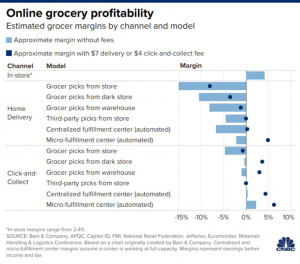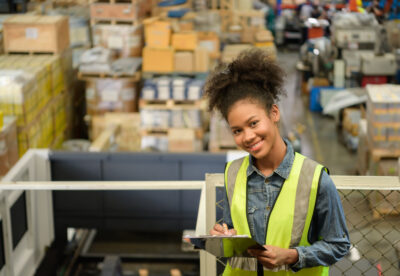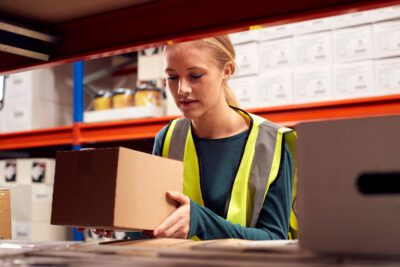Webinar Registration: The P2G Advantage
Webinar Registration: The P2G Advantage LEARN MORE
Cost-effective automation reaches profitable fulfillment for grocers with small margins
Melissa Valentine, Vice President, Sales (North America)

By Melissa Valentine | Director of Retail, Locus Robotics
When large companies like Walmart are investing millions into new tech and innovation, it’s a sign of what’s to come in a post-pandemic economy. It’s a sign that online grocery shopping shifts are going to continue after a 28% jump due to in-store shopping concerns during the pandemic, according to the recent Food Marketplace Inc (FMI) report. Customers that have switched to online grocery shopping are expected to continue benefitting from the convenience into the future.
Walmart, the largest seller of groceries in the world, is automating the online grocery pickup and delivery process using an autonomous mobile cart located in the back of the store. It increases the capacity of each associate’s workload by completing more orders than would be possible if associates walked down aisles, or even in a similar back-of-house environment, picking goods to fulfill orders.
Global race for automated profitability
Walmart is just one of several large grocers to recently announce a large investment in robotic automation technology. Wakefern Food Corp, the 20th largest seller of groceries in the US, debuted a microfulfillment center featuring a large infrastructure of robotic pickers and conveyor belts that can assemble a 60-item order in roughly five minutes. Associates pick only about 5% of the order manually with traditional hand-pulled carts, drastically reducing time spent traveling and retrieving goods for orders. Kroger has also invested $55 million into microfulfillment centers.
This shift towards robots for grocery picking isn’t limited to the United States; Ocado in the UK has been able to withstand many of the effects of the pandemic due to the flexibility of the automation solution for its online grocery business. It has no physical locations, but at one point had over 7,000 people lined up virtually to shop for groceries online at the same time. Rami Levy, the largest grocer in Israel, is fulfilling online grocery orders in a large underground warehouse using mobile warehouse robots.
Seeking cost-effective flexibility
The pandemic has created an urgent demand for flexible solutions that can operate efficiently despite fluctuations in the economy and changes in the marketplace. Robotic automation has gained popularity over the last 5-10 years, and companies that have adopted the technology early have been able to adapt to safety-focused requirements caused by the coronavirus pandemic including BOPIS (buy online, pickup in store), BORIS (buy online, return in store), curb-side pick-up, and 1-2 hour rapid delivery.
 However, the effects of this shift are not nearly over; there is a new normal ahead and grocers need to adopt automation technology to stand a chance against competitors. The biggest challenge grocers face in fulfilling online orders is profitable fulfillment, and many are trying to find the balance between an investment in automation while generating revenue with small margins.
However, the effects of this shift are not nearly over; there is a new normal ahead and grocers need to adopt automation technology to stand a chance against competitors. The biggest challenge grocers face in fulfilling online orders is profitable fulfillment, and many are trying to find the balance between an investment in automation while generating revenue with small margins.
Options for grocers with small margins
The decision to automate has to be affirmative, and there are several opportunities to integrate robots that grocers are evaluating and implementing. Large decision factors will narrow down that list including cost, size, infrastructure requirements, and operational downtime during installation. For example, robots that run on a grid require massive infrastructure planning and changes, and in most cases cannot be installed in the same space that current operations are running.
Robotic arms can pick groceries effectively but cannot be the only solution implemented; they require a hybrid automation solution, working in tandem with conveyor belts and other robots or machines to fulfill orders, which is very costly. For these reasons, many companies are turning to a multi-bot solution that requires little infrastructure changes, can be installed in working operations, and multiplies the productivity of workers while returning an ROI within months instead of years.
The multi-bot solution
The multi-bot solution uses autonomous mobile robots (AMR) and runs on a Robots-as-a-Service (RaaS) model, essentially removing the up-front capital costs that cripple many plans to automate. Stores and warehouses monitor their demand in real-time and place an order for additional robots when volume increases, then send them back to return to the baseline operation. The fleet of robots is also safe enough to operate in BOH or FOH environments, fulfilling orders from a stockroom or traveling between aisles to the many locations of goods.
A multi-bot solution is so flexible, it is capable of high performance in hybrid human-centric environments as well as dark microfulfillment (MFC) or ecommerce fulfillment (EFC) centers. Being highly portable as well, it does not limit grocers to keep unbusy robots in a particular store site as robots can be moved between multiple sites based on demand. This power of flexibility strengthens operations to weather through the most unexpected demand increases or changes; it future-proofs the entire operation.
Small and large grocers reap the benefits of a multi-bot solution to solve some of the most difficult problems including order accuracy, training, and social distancing. Store associates and warehouse workers express positivity and excitement about their robot coworkers and experience improved personal job performance as their order accuracy reaches near-perfect rates. In current pandemic conditions, a multi-bot solution provides social distancing measures as part of its design, maintaining a grocer’s high productivity while complying with CDC guidelines.
Learn more about what executives and managers are saying about the Locus multi-bot solution in their operations and how their IT integration teams have had success deploying the Locus multi-bot solution.
While the future of automated grocery fulfillment began several years ago, the coronavirus pandemic has accelerated the timeline for requiring robotic automation to give grocers a chance to emerge strong in a highly saturated, highly affected market.
About the Author
Melissa brings over 20 years of experience working with global retailers and brands to Locus. Prior to joining the Locus Sales team in 2019, Melissa spent 5 years helping customers solve complex supply chain challenges, via enterprise software and consulting services at Blue Yonder (JDA) and o9 Solutions. Melissa has a tenured career delivering sales results in high-growth companies as well as extensive expertise in Omni-channel Retail and Supply Chain. She builds long-term consultative relationships with her customers and partners. Melissa holds a BA from Washington University in St. Louis, and a Master’s in Counseling from Tulane University.




